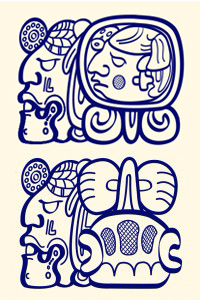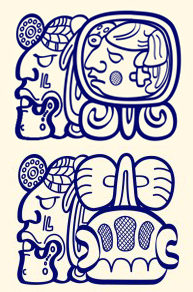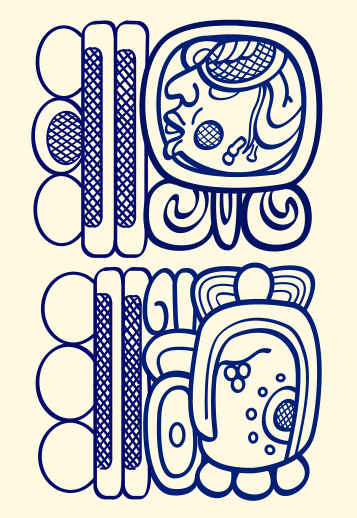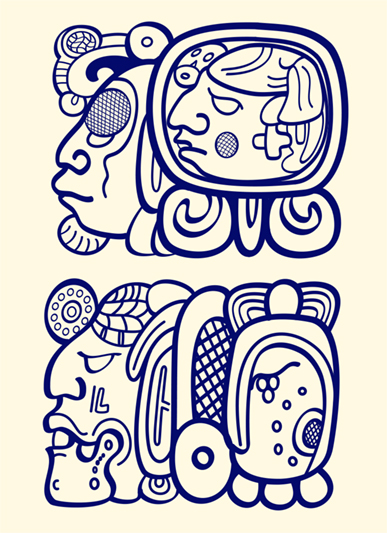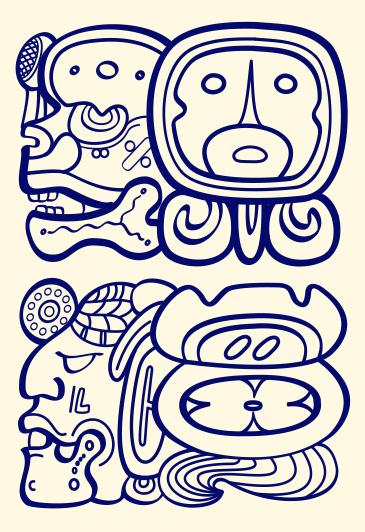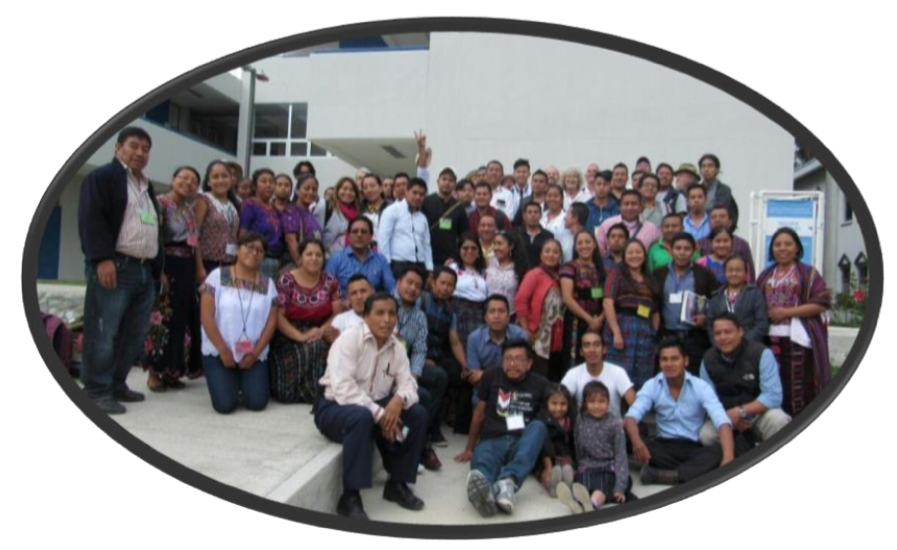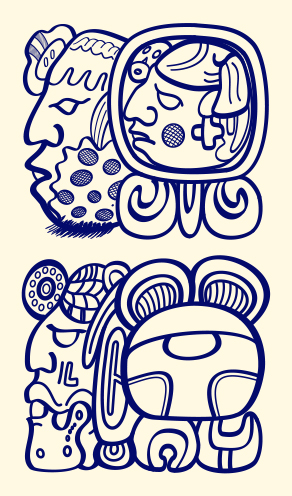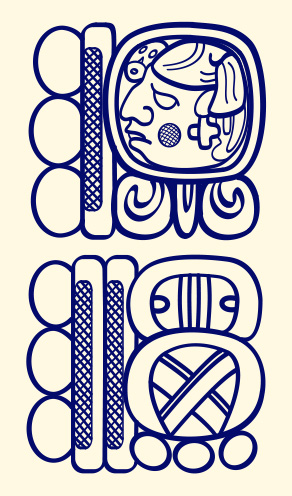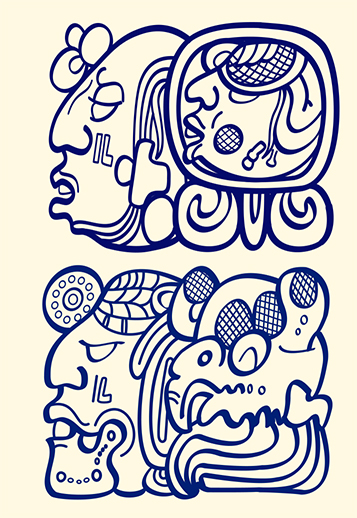
1 Ajaw 13 Muwan. Drawing by Jorge Pérez de Lara
On this most auspicious day, 1 Ajaw, the namesake of the Hero Twin in the Popol Vuh, we welcome the Gregorian New Year, and we look forward to the 5th International Congreso on Ancient Maya Writing to take place in 2020. Working with Omar Chan of Quintana Roo and the Congreso planning committee, we have proposed a tentative date for the next Congreso to take place on this same Tzolk’in day 1 Ajaw, on June 22nd, 2020. This is just two cycles of 260 days in the future, which was a known cycle that Maya astronomers used to predict eclipses. Quite remarkably, there will be a total lunar eclipse tomorrow night, on January 20th, visible in the Maya area and in North America, and there will be a total solar eclipse on the summer solstice in 2020, just one day prior to the proposed Congreso date—though this solar eclipse will only be visible on the other side of the Earth—so we are safe!
Following our announcement that we have funding available for our next round of mini-grants, we now have received twelve applications and we continue to receive more. We will fund as many as our budget allows, and I will announce the recipients in our next blog.
This month, we take a look at a report from last year, but I want to make sure that we do not neglect to publish it. Juan Jesús Méndez Intzín, or Xun as I know him, is an extraordinary person, and one of the advanced students who regularly attends the Congresos. He is a native speaker of Tseltal from Chiapas, and one of a new generation of Maya people who is also an archaeologist, working towards his graduate degree in archaeology. Juan organized and taught an extensive introductory course on Maya writing for Maya students at the Colegio de Bachilleres de Campeche (COBACAM) in Xpujil, Campeche last April, including a visit to the site of Becan. This area, surrounding the large ancient site of Calakmul, has been one of the most heavily looted regions in the Mundo Maya, and part of Juan’s interest is to help prevent further looting through education, helping Maya people appreciate their rich heritage.
Juan’s groundbreaking work has been made possible by the generous contributions of donors like you. We are eternally grateful for your help, and for the important work Juan is doing, and we wish him well in his future goals. May there be many more native Maya archaeologists that follow in his footsteps.
Wakolowal ta a pisilik,
Michael J. Grofe, President
MAM
 Recognition of the cultural and epigraphic development of Becán
Recognition of the cultural and epigraphic development of Becán
Introduction to Maya Hieroglyphic Writing in Xpujil, Calakmul
Juan Jesús Méndez Intzín
This report is the result of the activities carried out as part of the course-workshop called “Introduction to Maya Hieroglyphic Writing” in the facilities of the Colegio de Bachilleres de Campeche (COBACAM), campus # 14 with headquarters in the municipality of Xpujil, Calakmul, Campeche (Mexico) in April 24-26 of 2018. This was organized for community members with no knowledge about the subject.

1 Ajaw 13 Muwan. Dibujo por Jorge Pérez de Lara
En este día más auspicioso, 1 Ajaw, homónimo del Héroe Gemelo en el Popol Vuh, le damos la bienvenida al Año Nuevo Gregoriano y esperamos con anticipación que el 5º Congreso Internacional sobre Escritura Maya Antigua tenga lugar en 2020. Trabajando con Omar Chan de Quintana Roo y el comité de planificación del Congreso, propusimos una fecha tentativa para el próximo Congreso que tendrá lugar en este mismo día del Tzolk’in, 1 Ajaw, el 22 de junio de 2020. Esto es solo dos ciclos de 260 días en el futuro, que era un ciclo conocido que los astrónomos mayas usaban para predecir los eclipses. Muy notablemente, habrá un eclipse total de luna mañana por la noche, el 20 de enero, visible en el área maya y en América del Norte, y habrá un eclipse total de sol en el solsticio de verano en 2020, solo un día antes de la fecha propuesta para el Congreso—aunque este eclipse solar solo será visible en el otro lado de la Tierra, ¡así que estamos sanos y salvos!
Tras el anuncio de que tenemos fondos disponibles para nuestra próxima ronda de mini-becas, ahora hemos recibido doce solicitudes y seguimos recibiendo más. Financiaremos tanto como nuestro presupuesto lo permita, y anunciaré a los destinatarios en nuestro próximo blog.
Este mes, echamos un vistazo a un informe del año pasado, pero quiero asegurarme de que no olvidemos publicarlo. Juan Jesús Méndez Intzín, o Xun como lo conozco, es una persona extraordinaria, y uno de los estudiantes avanzados que asisten regularmente a los Congresos. Él es un hablante nativo de Tseltal de Chiapas, y uno de una nueva generación de personas mayas que también es arqueólogo, trabajando para obtener su título de posgrado en arqueología. Juan organizó e impartió un extenso curso introductorio sobre escritura maya para estudiantes mayas en el Colegio de Bachilleres de Campeche (COBACAM) en Xpujil, Campeche, en abril pasado, que incluyó una visita al sitio de Becan. Esta área, que rodea el gran y antiguo sitio de Calakmul, ha sido una de las regiones más saqueadas del Mundo Maya, y parte del interés de Juan es ayudar a prevenir más saqueos a través de la educación y ayudar a los mayas a apreciar su rica herencia.
El innovador trabajo de Juan ha sido posible gracias a las generosas contribuciones de donantes como ustedes. Estamos eternamente agradecidos por su ayuda y por el importante trabajo que Juan está realizando, y le deseamos lo mejor en sus metas futuras. Que haya muchos más arqueólogos mayas nativos que sigan sus pasos.
Wakolowal ta a pisilik,
Michael J. Grofe, Presidente
MAM

Reconocimiento del desarrollo cultural y epigráfico del sitio arqueológico de Becán
Introducción a la escritura jeroglífica maya en Xpujil, Calakmul
Juan Jesús Méndez Intzín
El presente informe es el resultado de las actividades realizadas como parte del curso-taller denominado “Introducción a la Escritura Jeroglífica Maya” en las instalaciones del Colegio de Bachilleres de Campeche (COBACAM), plantel # 14 con sede en el municipio de Xpujil, Calakmul, Campeche (México) durante los días 24, 25, 26 y 27 de abril del presente año. Un trabajo dirigido originalmente a los pobladores del municipio con nulo conocimiento acerca del tema. Continue reading



